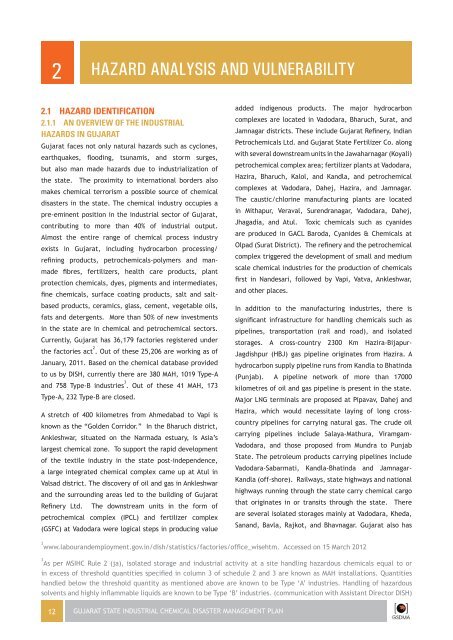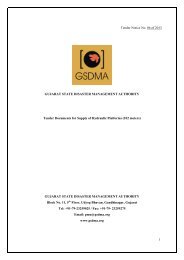GUJARAT STATE CHEMICAL DISASTER MANAGEMENT PLAN
GUJARAT STATE CHEMICAL DISASTER MANAGEMENT PLAN
GUJARAT STATE CHEMICAL DISASTER MANAGEMENT PLAN
- No tags were found...
Create successful ePaper yourself
Turn your PDF publications into a flip-book with our unique Google optimized e-Paper software.
2HAZARD ANALYSIS AND VULNERABILITYASSESSMENT2.1 HAZARD IDENTIFICATION2.1.1 AN OVERVIEW OF THE INDUSTRIALHAZARDS IN <strong>GUJARAT</strong>Gujarat faces not only natural hazards such as cyclones,earthquakes, flooding, tsunamis, and storm surges,but also man made hazards due to industrialization ofthe state. The proximity to international borders alsomakes chemical terrorism a possible source of chemicaldisasters in the state. The chemical industry occupies apre-eminent position in the industrial sector of Gujarat,contributing to more than 40% of industrial output.Almost the entire range of chemical process industryexists in Gujarat, including hydrocarbon processing/refining products, petrochemicals-polymers and manmadefibres, fertilizers, health care products, plantprotection chemicals, dyes, pigments and intermediates,fine chemicals, surface coating products, salt and saltbasedproducts, ceramics, glass, cement, vegetable oils,fats and detergents. More than 50% of new investmentsin the state are in chemical and petrochemical sectors.Currently, Gujarat has 36,179 factories registered underthe factories act 2 . Out of these 25,206 are working as ofJanuary, 2011. Based on the chemical database providedto us by DISH, currently there are 380 MAH, 1019 Type-Aand 758 Type-B industries 3 . Out of these 41 MAH, 173Type-A, 232 Type-B are closed.A stretch of 400 kilometres from Ahmedabad to Vapi isknown as the “Golden Corridor.” In the Bharuch district,Ankleshwar, situated on the Narmada estuary, is Asia’slargest chemical zone. To support the rapid developmentof the textile industry in the state post-independence,a large integrated chemical complex came up at Atul inValsad district. The discovery of oil and gas in Ankleshwarand the surrounding areas led to the building of GujaratRefinery Ltd.The downstream units in the form ofpetrochemical complex (IPCL) and fertilizer complex(GSFC) at Vadodara were logical steps in producing value12 <strong>GUJARAT</strong> <strong>STATE</strong> INDUSTRIAL <strong>CHEMICAL</strong> <strong>DISASTER</strong> <strong>MANAGEMENT</strong> <strong>PLAN</strong>added indigenous products. The major hydrocarboncomplexes are located in Vadodara, Bharuch, Surat, andJamnagar districts. These include Gujarat Refinery, IndianPetrochemicals Ltd. and Gujarat State Fertilizer Co. alongwith several downstream units in the Jawaharnagar (Koyali)petrochemical complex area; fertilizer plants at Vadodara,Hazira, Bharuch, Kalol, and Kandla, and petrochemicalcomplexes at Vadodara, Dahej, Hazira, and Jamnagar.The caustic/chlorine manufacturing plants are locatedin Mithapur, Veraval, Surendranagar, Vadodara, Dahej,Jhagadia, and Atul. Toxic chemicals such as cyanidesare produced in GACL Baroda, Cyanides & Chemicals atOlpad (Surat District). The refinery and the petrochemicalcomplex triggered the development of small and mediumscale chemical industries for the production of chemicalsfirst in Nandesari, followed by Vapi, Vatva, Ankleshwar,and other places.In addition to the manufacturing industries, there issignificant infrastructure for handling chemicals such aspipelines, transportation (rail and road), and isolatedstorages. A cross-country 2300 Km Hazira-Bijapur-Jagdishpur (HBJ) gas pipeline originates from Hazira. Ahydrocarbon supply pipeline runs from Kandla to Bhatinda(Punjab). A pipeline network of more than 17000kilometres of oil and gas pipeline is present in the state.Major LNG terminals are proposed at Pipavav, Dahej andHazira, which would necessitate laying of long crosscountrypipelines for carrying natural gas. The crude oilcarrying pipelines include Salaya-Mathura, Viramgam-Vadodara, and those proposed from Mundra to PunjabState. The petroleum products carrying pipelines includeVadodara-Sabarmati, Kandla-Bhatinda and Jamnagar-Kandla (off-shore). Railways, state highways and nationalhighways running through the state carry chemical cargothat originates in or transits through the state. Thereare several isolated storages mainly at Vadodara, Kheda,Sanand, Bavla, Rajkot, and Bhavnagar. Gujarat also has2www.labourandemployment.gov.in/dish/statistics/factories/office_wisehtm. Accessed on 15 March 20123As per MSIHC Rule 2 (ja), isolated storage and industrial activity at a site handling hazardous chemicals equal to orin excess of threshold quantities specified in column 3 of schedule 2 and 3 are known as MAH installations. Quantitieshandled below the threshold quantity as mentioned above are known to be Type ‘A’ industries. Handling of hazardoussolvents and highly inflammable liquids are known to be Type ‘B’ industries. (communication with Assistant Director DISH)
















